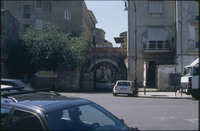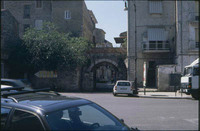| dc.description | FUNDI (Φοῦνδοι: Eth. Φουνδανός, Fundanus: Fondi), a city of Latium, in the more extended sense of the term, situated on the Appian Way between Tarracina and Formriae, and about 5 miles from the sea-coast. In the marshy plain between it and the sea is a considerable lake or pool, known in ancient times as the LACUS FUNDANUS (Plin. Nat. 3.5. s. 9), and still called the Lago di Fondi. The city was probably at one time in the hands of the Volscians; and in B.C. 340, during the great Latin War, it would appear to have occupied a sort of neutral position between the Latins and Campanians, and, as well as its neighbour Formiae, continued faithful to the Romans during that trying period. For this conduct the inhabitants of both cities were rewarded with the Roman “civitas,” but without the right of Suffrage. (Liv. 8.14.) Shortly after this, however, a part of the citizens of Fundi joined in the revolt of their neighbours of Privernum, under the lead of Vitruvius Vaccus, who was himself a native of Fundi. But the authorities of the city succeeded in excusing themselves to the Roman senate, and escaped without punishment. (lb. 19.) They did not however obtain the full Roman franchise with the right of voting till B.C. 190, when they were for the first time enrolled in the Aemilian tribe. (Liv. 38.36; Veil. Pat. 1.14.) Hence it is to this interval that Pompeius Festus must refer when he speaks of Fundi as well as Formiae as having been in the condition of praefecturae. (Fest. p. 233.) At a subsequent period it received t colony of veterans under Augustus (Lib. Colon. p. 234), and appears to have continued under the Roman empire to be a flourishing municipal town (Strab. 5. p. 234; Mel. 2.4.9; Plin. Nat. 3.5. s. 9; Ptol. 3.1.63; Orell. Inscr. 821, 2951), for which it was probably indebted to its situation on the Appian Way, which is here compelled to deviate from the sea-coast, and make an angle inland from Tarracina to Fundi, and thence again to Formiae, where it rejoins the coast. According to the Itineraries, Fundi was distant 13 miles from each of the above towns. (Itin. Ant. pp. 108, 121: Itin. Hier. p. 611.) The mention of its name by Horace on his journey to Brundusium, and the ridicule cast by him on the pompous airs assumed by its local magistrate or praetor, Aufidius Luscus, are familiar to all readers. (Hor. Sat. 1.5. 34.) It is incidentally mentioned also by Cicero and Suetonius, from whom we learn that the family of Livia, the wife of Augustus, came originally from Fundi: some writers also represented Tiberius himself as born there. (Cic. ad Att. 14.6; Suet. Tib. 5, Cal. 23, Galb. 8). Silius Italicus seems to include Fundi as well as Caiëta in Campania (8.524--530), but it is certain that they were both comprised within Latium, according to the bounds assigned to it under the Roman empire, or what was called Latium Novum. [LATIUM]
The modern city of Fondi still retains the ancient site, and considerable remains of antiquity, of which the most important are an ancient gateway with a portion of the walls adjoining it, the lower part of which is of polygonal construction, and the upper part of later Roman style. An inscription over the gate (now called the Portella) records the construction of the walls and gates of the city by the local magistrates or aediles. (Hoare, Class. Tour, vol. 1. p. 106.) The principal street of the town is still formed by the Via Appia, and retains great part of the ancient pavement: numerous fragments of ancient buildings are also scattered throughout the modern town, or have been employed in the middle ages in the construction of its castle, cathedral, &c.
Fundi was celebrated among the Romans for the excellence of its wines: the famous Caecuban wine was in fact produced within its territory [CAECUBUS AGER], but besides this the wine of Fundi itself (Fundanum vinum) seems to have enjoyed a high reputation, though inferior to that of the Caecuban and Falernian. (Martial (Mart. 13.113; Plin. Nat. 14.6. s 8.) It was probably on this account that the “Fundanus ager” was one of those districts which the agrarian law of Servilius Rallus sought to apportion among the needy citizens of Rome. (Cic. de Leg. Agr. 2.2. 5)
[E.H.B] | en_US |



